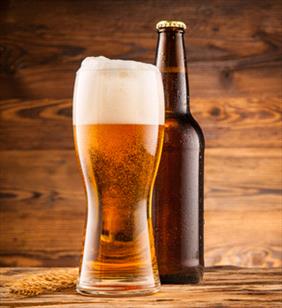bottle and glass of beer

Drinking and driving is stupid, but alcohol has a definite place in veterinary medicine.
Of course, there’s the typical use as a sterilizing/disinfecting agent. You can soak surgical instruments in alcohol to kill germs. You can dowse the patient’s incision site with alcohol before making the first cut through the skin. Veterinarians have been doing this for years in the field. Accidentally dropped the Burdizzo emasculator? Clean off the dirt, drop it into a tray or bucket of alcohol for a few seconds, and you’re good to go.
Then there’s ethanol as treatment. Believe it or not, pure ethanol is the standard treatment for antifreeze poisoning. Why pure? Because it’s given IV (intravenously), and you don’t want to be injecting “impurities” into veins. Quick science lesson: antifreeze contains ethylene glycol, which the body tries to clear out using an enzyme called alcohol dehydrogenase. That enzyme starts the process of turning ethylene glycol into glycoxylate and oxylate. Those two substances form insoluble crystal precipitates in the kidneys, leading to acute renal failure and, often, death. These days, there are drugs such as fomepizole (Antizol) that can be given to block that enzyme and save your pet's kidneys. But many veterinarians don’t have fomepizole on hand, and successful treatment relies on rapid intervention. On the other hand, Everclear can be purchased at almost any liquor store (this can differ from state to state). Your vet adds a hefty slug to some IV fluids and keeps it flowing for 48 hours. Of course, after a two-day IV drinking binge, Fido has a hangover like you wouldn’t believe. Serves him right for drinking out of the toilet bowl at the cabin.
Occasionally, veterinarians can use the destructive properties of alcohol to their advantage. In a procedure called alcohol ablation, specialist clinicians can inject alcohol into the parathyroid gland to destroy the over-exuberant gland without damaging the surrounding tissues.
Sometimes it’s not the alcohol, but the receptacle that is useful. Large, empty 750ml beer bottles come in handy when trying to replace a prolapsed uterus in a cow. Occasionally, after calving, a cow keeps pushing and turns her entire uterus inside out (known as a prolapse). I know! Yuck! What should normally be inside the cow is now outside, on the ground. And it’s swollen, and if not put back inside, can become a serious problem. So where does the beer bottle come into it? Well, a cow’s uterus has two horns, each extending towards the respective ovary. These horns, in a cow that has just delivered a 100 lb calf, can be 3 feet long. To get it back into place, you have to push it all in and invert each horn to its tips. Imagine a knee-high sock that’s turned inside-out. You need to take the toe end of the sock and push it all the way through the sock until it’s completely inverted. If you leave the tip not fully inverted, the cow will just push the whole thing out on you, and you’re back where you started. But I still haven’t explained about the beer bottle. Here’s the trick. First, you have the farmer drink the beer. Then you get down on the ground and push in as much of the uterus as you can. The problem is that most vets can’t reach the tips of the uterine horns with their hands to make sure the entire uterus is inverted. So you grab the now-empty beer bottle by the top, and use the blunt base to help push the tips of the uterine horns into place. Voila, tips are inverted, you remove the bottle, and then you can wash up.
Then there’s Beauregarde.
Beauregarde was a boar. A really big boar. Think 600 pounds. His owner, Joe, a local farmer, finally decided that Beauregarde’s manhood was making him a little too difficult to handle so it came time for Beauregarde to lose the family jewels. Unfortunately, getting anywhere near Beauregarde with a needle was impossible. He just didn’t like needles, and he didn’t care too much for vets. It’s really hard to win an argument with a 600 lb pig that doesn’t like you. But Beauregarde had a weakness and its name was Old Milwaukee. In fact, Farmer Joe would occasionally share a can or two with Beauregarde – the pig would just grab the opened can in his snout and up-end it until it was empty, chugging it like a college student at a frat party! So a plan was concocted. Farmer Joe would get Beauregarde drunk enough that he would pass out. Then the veterinarian would sneak up, top him off with some tranquilizer, and perform the necessary theft of the family jewels.
Farmer Joe brought out two cases of Old Milwaukee, opened a can, handed it to Beauregarde and, true to form, Beauregarde up-ended it. Joe opened another can. Beauregarde guzzled it. Can number three. Number four. As fast as Farmer Joe could open them, Beauregarde drank them. Somewhere around can number 15, Beauregarde started to show a little incoordination. Farmer Joe only had nine cans left. Twenty cans gone and Beauregarde was a happy, but still upright, drunk. Finally, at can 23, Beauregarde lay down, grunting contentedly and decided he needed a nap. The veterinarian waited a few more minutes, giving the 23 cans that Beauregarde had consumed a little more time to take effect, and went to work. Job done, Farmer Joe and the veterinarian shared the last can. Beauregarde eventually awoke, and I suspect he didn’t know whether it was his head or his nether regions that hurt more.
Now, anybody need a drink?